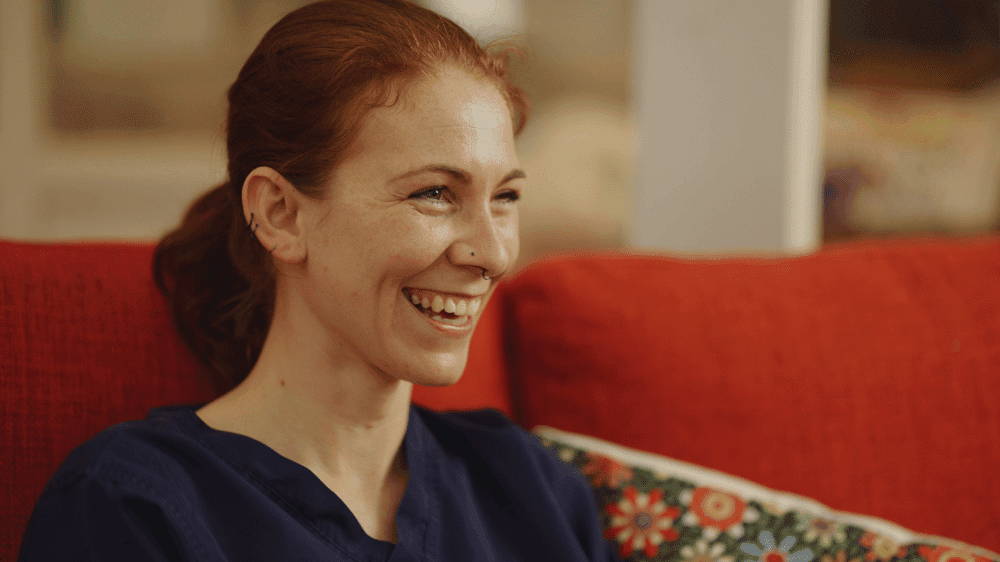Lucy Butters is nurse on our care team here at Helen & Douglas House. As no day is ever the same, we asked her to talk us through the experience of a ‘typical day in the life of Helen House nurse’ from the point of view of working within the care team. Here, she tells her story…
‘At one point you might be creating crafts in the art room with a child, whilst your colleague might be with a child in their bedroom managing their difficult symptoms. On these occasions, we try to take time out and swap roles to make sure staff are looking after themselves too.’
Hello, I’m Lucy…
I’m Lucy and I am lucky enough to have worked at Helen & Douglas house for just over five years. When I started here, I was fairly newly qualified and in my first decade of Nursing. I thought I might work at Helen House for around two years to explore my horizons. Five years on, I realise I am not going anywhere soon and I simply can’t imagine working anywhere better. Children’s palliative care has become my area of interest and I think, if anybody can both want to both be at work and want to talk about their job when they’re out of work, that they’re probably working in the right place.

A typical day at the hospice
A typical day at Helen House is usually orientated around the children. Until you’ve been allocated the child you’re going to care for that day, you have no idea which direction your day is going to go in. Throughout the day, we have three handover times – one at 7:30am, a second one at 2pm, and another at 9pm. This is when you will find out which child you will be caring for that day. This is also the point when you are given the child’s key medical information. After this, there is a bedside handover which is done by the staff member who was already caring for the child. This usually includes a run-down of what activities the child wants to do, what they might already be part-way through, and what they feel is important for them to be able to do on that particular day. Sometimes it might even be what the child wants to be called as we have many children who may decide to change their name for the day, or similar.

Home-from-home care
We try to make sure that the hospice feels like a home for the children who stay with us, so that any changes that may cause anxiety or distress are minimised. When children and their families come in, we meet with them to help us to understand their normal routine at home. As much as possible we will try to keep a child’s routine from home, but always with a little bit of added ‘magic’ and extra fun along the way! Their routine helps them to feel safe and comfortable.
We have children of all ages, from newborns to those aged 18, some may be medically stable and coming for a respite stay away from their parents, and others may be more unstable and require more symptom management or end-of-life care. The variety of children we care, and their complex conditions, means that the routines can vary a lot, and two people working the same shift together can have a completely different day.

‘Every day is different – at one point you might be creating crafts in the art room with a child, whilst your colleague might be with a child in their bedroom managing their difficult symptoms. On these occasions, we try to take time out and swap roles to make sure staff are looking after themselves too.’
Wearing many ‘hats’
As a member of staff at Helen & Douglas House, the ability to wear many hats at one time is essential. On any given day, moving between one role and another can be difficult, so you must be aware and learn what a child and family needs, quickly and efficiently.
On any one day, we may need to;
- be a listening ear,
- bring fun, or deliver whatever a child needs, even if that is at 4 am, so they feel comfortable and secure,
- provide an unlimited supply of cuddles, for children and family members,
- be crafty and willing to take on an artistic challenge, even if we don’t have the skills!
- be experts in symptom management,
- offer advice at any time of the day or night,
- bring confidence and be there as support,
- sometimes be a hand to hold, or a shoulder to cry on,
- be clinically skilled carers and give families time to trust us.
This is all to make sure each child we care for is as comfortable and confident as they can be, and that their day is full of joy.

A day as the key holder
On certain days, when we aren’t caring for the children individually, we may be the key holder on a shift. This role is similar to that of a matron on hospital wards and is very quite different to an individual caring role. The main job as the key holder is to ensure a smooth running of the shift, making sure the children are safe, the staff have administered medications and they feel supported. We also have to make sure we take a lead role in communicating and highlighting any concerns with the various teams we have such as our medical team, senior nursing team and the outreach and community nursing team.
Whilst no two days are the same, one thing that is very important at the hospice, and happens as a routine without fail is the mealtimes. Our catering staff in the kitchen are great at making sure that we have delicious food every day. With mealtimes comes laughter and smiles and brings children, family and staff together.
